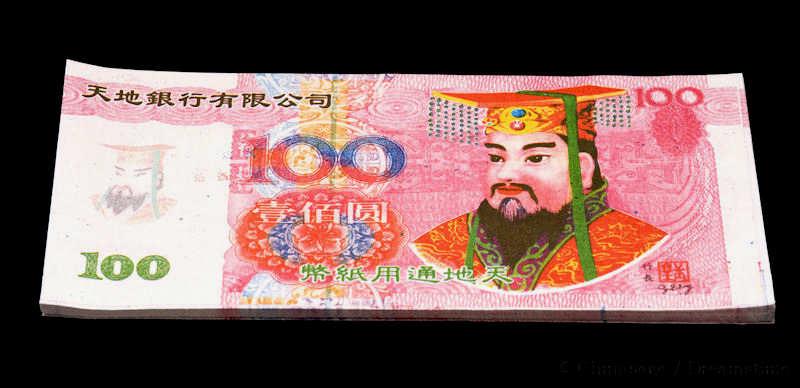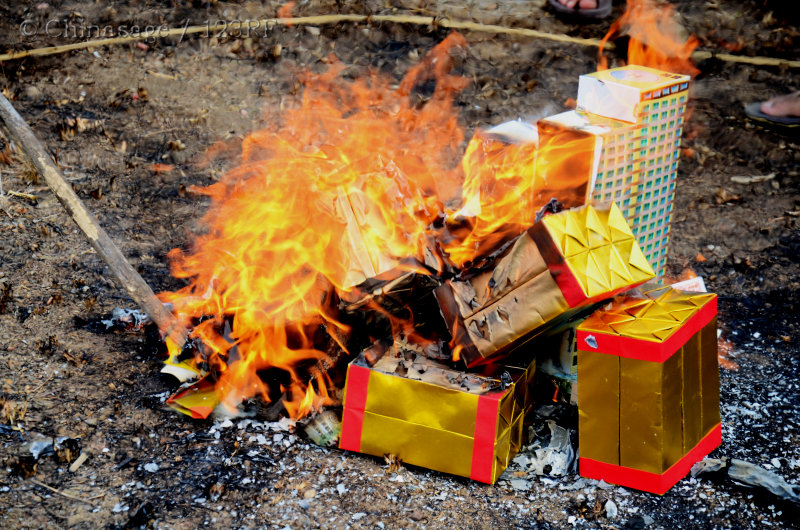History of Chinese Money
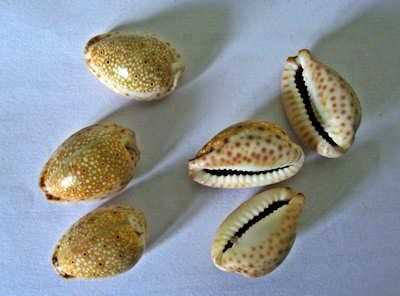
Chinese currency
China has a very long tradition of using coins. The same design of coinage lasted 2,000 years and it was the first country to introduce paper money. Other ancient forms of currency included a ‘bolt of silk’ in foreign trade with a standard monetary value and for government officials sacks of rice (Chinese measure dàn 担). For many centuries remote communities bartered crops at markets rather than using money. The quality and value of coinage reflected the fortunes of the ruling dynasty, a decline in fortunes led to devalued and debased currency.
Cowrie shells
Cowrie shells were used as currency as far back as the Shang dynasty [1600-1100BCE]. The cowrie can still seen in characters for precious things; Bèi 贝 [Old form 貝] means shells or valuables. The character is used as a radical in the Chinese words for jiàn 贱 (cheap; worthless) 贵 guì (precious; expensive; honorable); 买 mǎi (buy) [Old form 買]; 卖 mài (sell); sì 赐 (bestow) and cái 财 (riches; valuables). The shells probably came from either the South China Sea or the Indian Ocean. As they are rare, cannot be forged and do not occur in China the amount of money was tightly controlled. Cowrie shells continued to be used in remote south western parts of China up to the Ming dynasty.
Cash coins
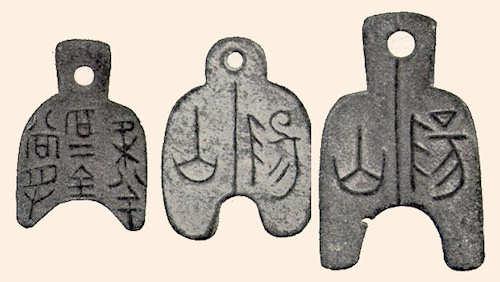
It was back in the Western Zhou dynasty [c. 1000BCE] that China started using metal coins. Advanced Chinese bronze workmanship provided the technology for the accurate casting of coins. As many as 80 coins were cast at a time using a mold made of clay, stone, brass or sand. The individual coin molds were interconnected in the form of a 'coin tree'. Initially bronze replicas of cowrie shells were produced before a change of design to produce castings of small spades (布币 bù bì) and knives (刀币 dāo bì). Another form used in the Warring States period was round money: 圆钱 yuán qián with a round hole, probably modeled on jade 璧 bì rings.
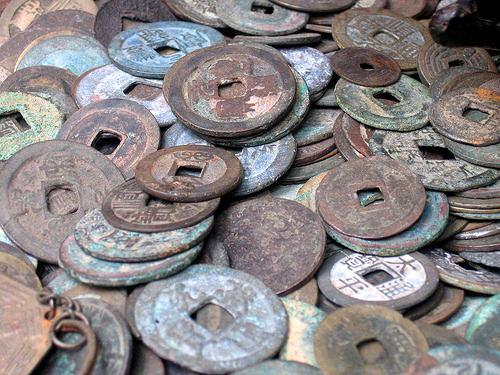
The Qin dynasty Emperor Shihuangdi standardized money, along with everything else. He introduced the 半两 bàn liǎng ‘half tael’ (equivalent to 12 铢 zhū) coin. It had a standard weight in the form of a round disc with a square hole. This shape of coin remained in use up to the 20th century. He also divided all currency between gold/silver: 上币 shàng bì and bronze: 下币 xià bì. The square central hole allows the coins to be conveniently and safely strung together (the earlier knife and spade currency often had a hole for the same reason). The shape also symbolizes the union of heaven (round) and earth (square). The copper coins were cast in a bronze mold and had two or four characters inscribed on them. A thousand coins strung together divided into ten groups of 100 were the next unit of currency as ‘a string of cash’ 吊 diào. The string would be braided rather than a single linear string. However care was needed in counting as unscrupulous traders would make strings with as few as 83 coins instead of 100.
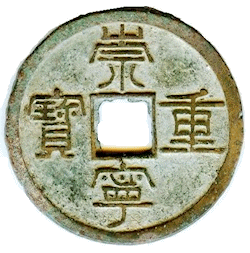
As with many other Qin reforms the following Han dynasty revised rather than replaced the currency. A much lighter coin, the 五铢 wǔ zhū was introduced in 118BCE, retaining the same shape with a standard weight [aZhu is a measure of weight]. The value was fixed so that 1 jin of gold coins was equal to 10,000 bronze Wu zhu coins.
However, during the Han dynasty the weight of the ban liang coins diminished to in some cases 1/30th of the weight they should have been and a variety of forms were produced. Emperor Liu Heng (Wendi) in 175BCE relieved a shortage of coins by licensing private mints, bringing great wealth to owners of copper mines, who then flooded the market which inevitably led to rapid devaluation of the currency. The following Emperor Wudi (187-180BCE) reintroduced the state monopoly and licenses for minting coins, but much illegal coinage was still produced. As a desperate measure Wudi introduced money made from pieces of rare white stag’s pelt so he had the monopoly of its supply. This novel currency soon also failed so he then introduced silver alloyed with tin as ‘white coins’. The circulation of illicit coins was eventually solved by restoring parity of value for their weight in copper so that there was no longer any benefit in forging coins any longer.
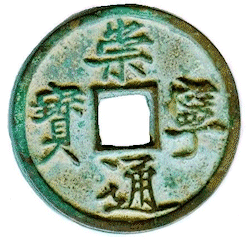
Wang Mang (9-23CE) introduced standard exchange rates between cowrie shells, bolts of cloth and other currencies. He insisted all gold was exchanged for copper. He amassed more gold than was at that time in the whole of Europe and this was one reason that Emperor Tiberius ➚ forbade the purchase of silk with gold. However his tight control over money supply restricted economic activity. He introduced many new types and values of coins including some fine, high value coinage in the shape of knives inlaid with gold. When the Eastern Han dynasty ousted Wang Mang the range of coinage was simplified and the Wuzhu was re-established as the everyday coinage.
In the following Period of Disunity small kingdoms and short lived dynasties created their own coinage. At the time of the Sui second unification of China, Emperor Wendi reintroduced a standard Wuzhu coin - the隋五铢 suí wǔ zhū. Then Emperor Wudi minted the kai yuan tong bao 开元通宝 which was no longer of standard weight, they were also known as 开元通宝 kāi yuán tōng bǎo, 重宝 zhòng bǎo or 元宝 yuán bǎo. So, the 700 years of Wuzhu coins came to an end, where the value of the coin was simply value of the metal it was made from. The new coins were in use for 200 years and used in Japan, Korea and Vietnam. By 850CE (Tang dynasty) eight copper mines provided all the copper for coinage. A hundred mints busily produced 327,000 strings of 1,000 cash coins each year. Each string weighed 6.4 pounds and was roughly equivalent in value to a liang (an ounce) of silver or a bolt of silk or a bushel of grain. Coinage gradually replaced the ‘bolt of silk’ as a unit of currency.
After more chaos in the Five Dynasties period, the Song dynasty introduced a great many variations of the tong bao coinage. By the year 997CE 800 million coins were produced each year - 2.5 times that made during the Tang. By 1085CE this had grown dramatically to 8 billion coins. The following Mongol dynasty used mainly paper currency and some silver; but ordinary people continued to use tong bao coins; some of which were in brass rather than bronze. When the Ming dynasty took over in 1368, the rulers increased the reliance on coinage and established controlled mints producing bronze coins in five denominations (1, 2, 3, 5 and 10). In 1375CE the weight and composition (100% copper) were stipulated. For larger denominations the Ming used silver rather than paper currency. Reforms during the early Qing dynasty standardized 1,000 cash coins to be worth the same as one tael (两 liǎng) of silver.
In Emperor Kangxi's reign the coins were minted with 60% copper and 40% lead. The high copper content led some to make money by melting them down and so in Emperor Yongzheng's reign the proportion was briefly changed to 50/50 making the coins softer with less clear detailing. The currency system broke down towards the end of the Qing, one important reason was that the Taiping Rebellion blocked off the supply of copper from American mines that was imported into southern China. The Taipings minted their own coinage during the Rebellion. At the same time the modern European minting machines replaced traditional casting for coin manufacture. The Republic of China finally ceased producing the standard round design with a square hole in favor of a plain disk.
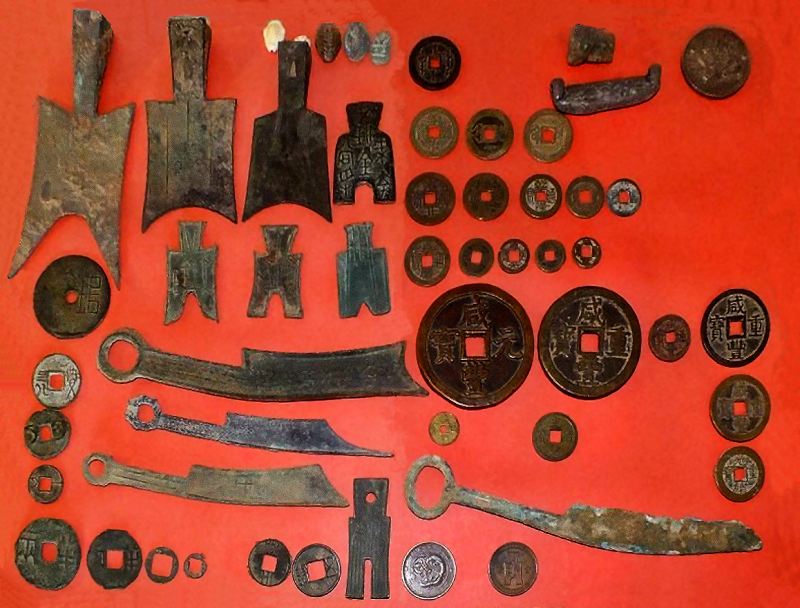
Silver money
The Chinese silver ingot was in the form of a boat or shoe and known abroad as ‘sycee ➚’ or in northern China as 元宝 yuán bǎo. Very few were produced compared to coins and they were cast by hand. Silver and gold were long considered of similar value in China. The alchemist's dream in China was to transmute base metal into silver not gold. Gold and silver were normally traded by weight and not minted as coinage, they were reserved for making jewelry and ornaments. Use of silver increased during the Song dynasty; by 1120CE a total tax of 18 million ounces of silver was collected. In the Ming dynasty an increased supply of silver reached China from Mexico and South America through trade with the Spaniards, and the Spanish Peso ➚ was accepted as currency in ports engaged in foreign trade. Later on the emancipation of silver miners in South America led to shortage of supply of silver in the later Qing dynasty, this was one reason why opium became a trading commodity.
Chinese Paper money
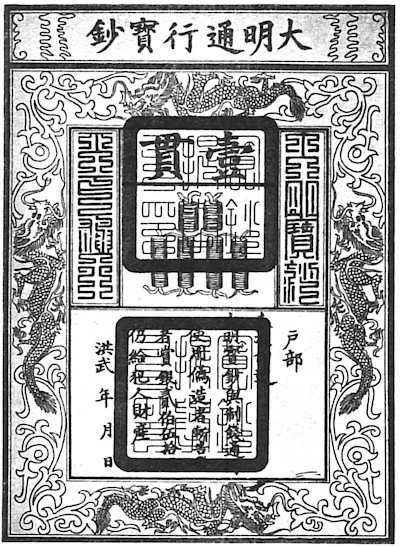
Paper money came into use in the Tang dynasty as a larger denomination of currency to replace the bulky ‘bolt of silk’ and heavy ‘strings of cash’. Originally paper money was really just an official printed receipt and it was called ‘Flying money’ 飞钱 fēi qián. It was far more convenient and safer to transport compared to the alternatives for large transactions. The money was printed in color on special paper (up to six colors by 1107CE) and was given a limited life - it had to be replaced or exchanged within three years. It was initially mistrusted when it was brought in by Wang Anshi. By the end of the Song dynasty paper money equivalent to 70 million strings of cash were being printed and became preferred to coins; the rulers imposed tight control over the supply of paper money so it could be trusted by the people. The Yuan dynasty tried to maintain the paper currency but inflation proved ruinous. Marco Polo was so impressed that a whole chapter of his great book ‘The Travels of Marco Polo’ was devoted to describing the paper money system and this led to the adoption of paper money in Europe. In the late Qing period there were many independent banks that all printed their own notes.
Modern paper currency is the 人民币 rén mín bì ‘People’s Currency’ and is denominated in yuan (CN¥) 元 yuán which is subdivided into 10 角 jiǎo also known as ( 毛 máo). Each jiao is subdivided into 10 分 fēn. Most money is in the form of paper notes but coins are used for denominations of 1 yuan and less – although nowadays the Chinese have widely embraced electronic cashless systems.
Myths and Legends
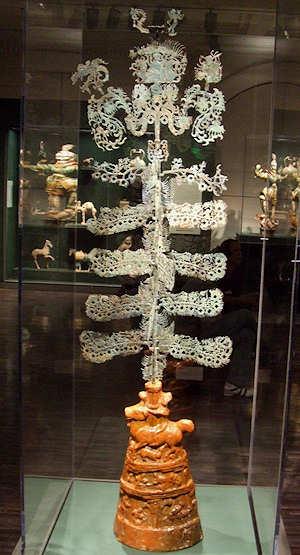
Coins were worn as amulets around the neck to ward off demons. This practice started in the Han dynasty and special coins were minted as charms and for casting the Yi Jing/I Ching. Reproductions of the Han dynasty wuzhu in gold, silver, jade and bronze are very common amulets. The ancient spade and knife money are also reproduced as charms. The ancient jade round coin with a round hole the 璧 bì is often used as an emblem to bring shops good fortune. Money has featured heavily in Chinese symbolism, 钱 qián (money) has the same sound as 前 qián (before) so money is often used to give the idea of ‘before’ . Similarly ‘eye’ (眼 yǎn) is the name given or the square hole in the coin, so a reference to an eye may refer to money.
Legends about money trees go back to at least the Three Kingdoms period, it is reputed that shaking the tree would bring a shower of copper coins. Decorative objects were made into the shape of a money tree and occur in burial goods. ‘Shaking the Money Tree’ 摇钱树 yáo qián shù is a popular opera often performed by children. The plot of the opera has a celestial lady in waiting coming down to earth to enjoy worldly life but the supreme lord has her dragged back up to heaven.
Specially printed symbolic money is used in ancestral rites and festivals. There is a ‘Bank of the Underworld ➚’ that is featured on the notes. Money is often presented as gifts in a lucky red envelope. Some symbolic money is produced just so it can be ritually burnt (particularly at funerals and Qing Ming). At weddings the bride was showered with special coins embossed with characters wishing good fortune on the marriage.
